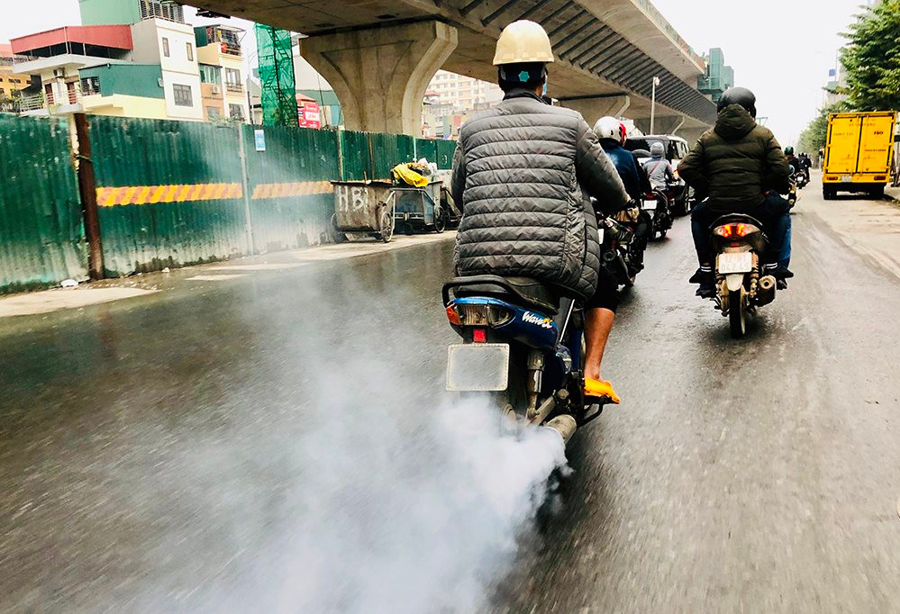According to the Vietnam Registry Agency – the agency responsible for drafting, motorcycles and motorbikes are the predominant means of transportation in Vietnam. Vietnam is also a country with the highest consumption and usage of motorcycles and motorbikes (two-wheelers, in general) in the ASEAN region and ranks fourth globally.
TRANSPORTATION IS A MAJOR SOURCE OF GREENHOUSE GAS EMISSIONS DUE TO HIGH CO2 EMISSIONS
As a popular and favored means of transportation in Vietnam, the emissions from two-wheeled vehicles are attracting the attention of administrators and environmental protectors. According to calculations, on average, transportation activities emit approximately 30 million tons of carbonic gas (CO2) annually, with road transport accounting for 85% of total emissions.
Scientists assert that transportation is the most significant contributor to greenhouse gas emissions among all economic sectors, accounting for an estimated 29%. Over 90% of the fuel used for transportation comes from petroleum, including gasoline and diesel. The increasing levels of greenhouse gas emissions are the primary driver of climate change.

A recent statistic reveals that as of the end of 2023, Ho Chi Minh City had approximately 10 million vehicles, including over 7.6 million motorcycles. Annually, the city emits around 35 million tons of CO2, with the industrial sector contributing 20 million tons and transportation accounting for about 13 million tons.
In the 2022 update of the Nationally Determined Contributions (NDC), Vietnam proposed ten solutions to reduce CO2 emissions from transportation activities. Among these solutions, setting fuel consumption limits for newly produced, assembled, and imported motor vehicles was identified as the most effective measure, contributing to a reduction of 34.33% of total CO₂ emissions in the transportation sector.
The Vietnam Registry Agency also shared that the country is currently implementing energy labeling for motorcycles and motorbikes that are newly produced, assembled from knock-down kits, or imported unused.
Specifically, the Vietnam Standard TCVN 7356:2014 on fuel consumption limits and methods for determining fuel consumption values for motorcycles and two-wheeled motorbikes, issued by the Ministry of Science and Technology in 2014, is not currently mandatory. If the fuel consumption limits specified in TCVN 7356:2013 continue to be applied, they will not effectively reduce CO2 emissions from the transportation sector.
THE NEED TO PROMULGATE NEW MANDATORY STANDARDS ON FUEL CONSUMPTION LIMITS AND EMISSIONS
Therefore, the Vietnam Registry Agency believes it is necessary to develop and promulgate new mandatory standards on fuel consumption limits and CO2 emissions. This move will not only help Vietnam become a pioneer in the ASEAN region and the world in establishing fuel economy standards for motorcycles and motorbikes but also accelerate the process of electrification.
A crucial aspect of the aforementioned draft standards is the proposal of fuel consumption limits and technical methods to determine fuel consumption levels. The draft suggests two methods for determining fuel consumption levels.
Method 1: Setting fuel consumption limits for each type of vehicle (Minimum Energy Performance Standards – MEPS)
Method 2: Determining the average fuel consumption of the entire fleet of vehicles by the manufacturer (Corporate Average Fuel Economy – CAFE)
According to the drafting agency, the simultaneous regulation of both MEPS and CAFE methods is intended to provide flexibility in management, allowing authorities to choose the appropriate model for each phase and specific objective.
Additionally, the Vietnam Registry Agency shared that, based on international experiences, many countries and regions are shifting from managing fuel consumption limits for individual vehicle models to managing the average fuel consumption of an entire fleet of vehicles from a single manufacturer. This means that vehicles with higher fuel efficiency can “offset” less efficient models within the same category of a manufacturer’s portfolio.
The agency also noted that stricter standards could be set for all vehicle types, rather than targeting individual models, to promote technological innovation while remaining achievable for manufacturers to meet energy consumption reduction goals.

















